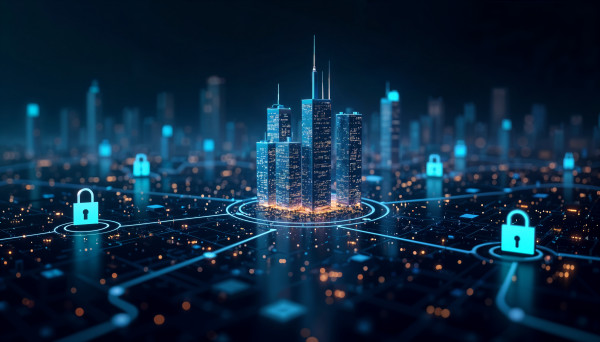Several attempts to generate digital money have already failed because trust is most important when it comes to money. What is the guarantee that the person X who invented the new money won’t award himself his X billion or take it from you?
To address this issue, Bitcoin was created using a database known as a blockchain. Most traditional databases, such as SQL databases, have someone in charge who can change the records (e.g., giving themselves a million X). However, blockchain is unique in that no one controls it; it is run by the individuals who use it. Furthermore, bitcoins cannot be counterfeited, hacked, or double-spent. So whoever owns this money is safe.
What is a Blockchain?
A blockchain is a distributed database or set of logs shared across computer network nodes. A blockchain, like a database, saves data electronically in a digital format. Blockchains are well recognized for their critical role in cryptocurrency systems like Bitcoin, where they keep a protected and decentralized record of transactions. What’s new about blockchain is ensuring the accuracy and security of records and establishing trust without the need for a trusted third party. Also, blockchain uses a specific way to store data that makes it hard or impossible to update, hack, or cheat the platform.
A blockchain keeps a digital record of transactions that are replicated and distributed throughout the entire network of computer systems that comprise the blockchain. Each block on the chain has a number of transactions in it, and each new transaction on the blockchain adds a record to the ledger of each participant.
Distributed Ledger Technology (DLT) is a decentralized database administered by several individuals. Blockchain is a type of distributed ledger technology that stores transactions with a cryptographic signature called a hash that can’t be changed.
This means that if one block in a chain was changed, it would be clear that the chain had been tampered with. So, for hackers to break a blockchain system, they would have to change every block in the chain and all of the copies that are spread out, which is very hard to do.
How does the blockchain operate?
Blockchain enables digital information to be recorded and shared, but not altered. A blockchain, in this sense, serves as the foundation for irrevocable ledgers or transactional records that cannot be changed, erased, or destroyed. This is why blockchains are often referred to as “DLTs.”
In recent years, many firms across the world have integrated blockchain technology. But how does blockchain technology work? Is this a substantial modification or a small addition? Blockchain innovation is still in its infancy and has the potential to revolutionize the future, so let’s take a closer look at this technology.
Blockchain is a hybrid of three major technologies:
- Cryptographic key
- A peer-to-peer network with a distributed database.
- A computer method for storing network transactions and records.
Cryptography keys are private and public keys that help in successful transactions between two participants. Each person uses these two keys to generate a secure digital identity reference. The most important element of blockchain technology is its secure identification. This identification is called a “digital signature” in the cryptocurrency space and is used to authorize and control transactions.
Many businesses are already looking into blockchain-based applications because they are a safe and inexpensive way to build and manage a distributed database and keep track of all digital transactions.
Blockchain Applications
Blockchain has several applications in every industry imaginable, including healthcare, banking, government, identification, etc. And that does not include its most popular use, Bitcoin.
Cryptocurrencies: One of the numerous benefits of adopting blockchain for cryptocurrencies is that it has no territorial boundaries. As a result, global transactions use cryptocurrencies. The only thing to remember is that exchange rates may fluctuate, and consumers may lose money.
If you’re into digital art and collectibles, non-fungible tokens might interest you. Non-fungible tokens (NFTs) are often constructed using the same programming as cryptocurrencies. To put it simply, these cryptographic assets are built on blockchain technology. Because of this, they can’t be traded or swapped like other cryptographic assets can.
Asset Management: Blockchain is becoming more and more important in the financial world, and asset management is no exception. Asset management is the process of keeping track of and trading different kinds of assets, like fixed income, real estate, stocks, commodities, mutual funds, and other investments.
Overseas Payment: Overseas payments may be lengthy and convoluted, with money arriving at its destination over several days. By enabling end-to-end remittance services without the need for intermediaries, blockchain has aided in the simplification of these cross-border transfers.
Healthcare: Using smart contracts, blockchain can significantly influence healthcare. These smart connections imply a contract between two parties without using an intermediary. The contract specifics are known to all parties concerned, and the agreement is automatically implemented when the contract criteria are satisfied.
Blockchain Security
Although headlines portray blockchain as anything but secure, the blockchain architecture that underpins current NFTs, cryptocurrencies, and decentralized apps includes several security protections. Once data blocks are uploaded to the blockchain database, they cannot be changed. A hacker cannot modify them to steal cash. Verifying blocks is done with the help of consensus procedures that weed out fake transactions and protect against hackers. The database is secured using financial-grade public-key encryption. These characteristics place the blockchain design among the most secure databases ever developed.
Despite this cutting-edge technology, hackers and fraudsters steal millions of euros yearly through DeFi scams, pump-and-dump schemes, and many other vulnerabilities. Because secure blockchain networks are part of an ecosystem, they are only as strong as their weakest link. The blockchain is safe in and of itself, although the standard security measures apply:
Secure Hardware Access: Anyone may quickly move all of your cryptos to some other account if you’re not present at your workstation while your PC is logged into your crypto wallet. Because blockchain accounts are anonymous, you’ll never know who did it and never get your cryptocurrency back.
Password Security: You are inviting catastrophe if you encrypt your crypto wallet using a password saved in a file called “passwords” on your hard disk.
Choose trustworthy apps: Hackers might exploit a weakness in the app’s code if you utilize a new and untested distributed finance app. Examine DeFi applications before entrusting them with your money. Only pick well-established and carefully maintained apps.
Blockchain and Bitcoin
Blockchain technology powered Bitcoin and was created exclusively for it. So, Bitcoin was the first illustration of blockchain in operation, and there would be no Bitcoin without blockchain. This is why the two names are frequently used interchangeably.
Bitcoin is a decentralized digital currency or peer-to-peer electronic payment system in which users can transfer bitcoins anonymously without any third-party authority’s intervention (a bank or government). However, Bitcoin is just one type of cryptocurrency; blockchain technology is also powering other cryptocurrency networks. So, Bitcoin uses the blockchain to trade digital currencies. However, the blockchain is more than just Bitcoin.
Smart contracts are a great way to make digital relationships official and make digital transactions possible with blockchain technology. Blockchain is the best way to keep long-term, safe, and clear records of assets that everyone can access securely. In addition, users may utilize the blockchain to trace ownership information for commodities back to their source.
Blockchain: Use Cases
Money Transfer: The cryptocurrency transfer applications pioneered by Bitcoin are now very popular. Blockchain is particularly popular in banking as it can save money and time for financial institutions of all kinds.
Smart Contracts: Smart contracts are similar to traditional contracts, except that the terms of the contract are applied in real-time on a blockchain, eliminating the intermediary and adding degrees of responsibility for all parties involved in a manner that traditional agreements can’t. This saves a firm time and money while also ensuring everyone’s compliance.
Internet of Things (IoT): The Internet of Things (IoT) is a natural step in the evolution of blockchain applications. IoT offers millions of uses and numerous safety issues. As the number of IoT products grows, hackers will have more opportunities to steal your data, from Apple’s Siri to a smart thermostat.
Blockchain Security: Fraud may take many forms, from fake documents to breaking into personal information. By putting social security numbers, birth certificates, birth dates, and other sensitive information on a decentralized blockchain database, the government could cut down on identity theft claims by a lot.
Benefits of Blockchain
Accessible: One of the primary benefits of blockchain technology is that it is open to all. This means that anyone can contribute to blockchain technology, and no one needs permission to join the distributed network.
Sustainable: Blockchain technology stores information in a decentralized fashion so that everyone may check the accuracy of the information by employing zero-knowledge proof, in which one party verifies the accuracy of data to another participant without exposing anything about the data.
Ageless: Because blockchain technology is a decentralized network with many trustworthy nodes, records or information recorded using blockchain technology are permanent. Duplicate copies are kept at each local node so that the data doesn’t get lost.
Immutability: Due to the decentralized nature of blockchain technology, any modification will be reflected in all nodes, making it impossible to commit fraud; hence, transactions may be tamper-proof.
Transparent: Transaction history is transparent as each node in the network has a copy of the transaction. All updates to the transaction are accessible from other nodes.
Higher Security: Blockchains use hashing algorithms to place each transaction into linked blocks. Store transactions using the SHA-256 hashing algorithm.
Reduced Cost: Because blockchain eliminates the need for a third party, businesses save money while gaining their partners’ confidence.
Challenges of Blockchain
While Blockchain technology may help enterprises of all sizes level the playing field, it also offers downsides and dangers for consumers and businesses using it.
Lack of Acceptance: Blockchains work better and more efficiently when they are used by a large network of people. A blockchain ecosystem, for example, would require consumers and suppliers to join the network. The technology will only be effective in the presence of widespread adoption.
However, there are some signs that blockchain adoption may continue. For example, businesses are starting to work together and form blockchain working groups to deal with similar problems and find solutions that could help everyone without revealing private information.
Rising Cost: It all comes down to early financial investments. Implementation costs may be high for certain businesses. Even if most existing solutions are free, considerable expenditure is necessary when recruiting professional software developers specializing in blockchain development, transitioning to a charged software version, providing overall administration, and more. It is one of the most significant blockchain implementation issues.
FAQs
1. What are the business benefits of blockchain?
Blockchain can easily track any product or commodity during shipment and the supply chain. It can send or receive information about the component to or from the current buyer so that the right action can be taken. It also gives you a better idea of this product’s qualities, where it comes from, and whether or not it’s real, which is especially important in countries where counterfeiting is common, as well as what effect it may have on the environment. In addition, it is feasible to exchange original data directly with customers via blockchain. Traceability data can also show problems in the supply chain, like products sitting on a loading dock for a long time before being shipped.
2. What is decentralization in blockchain?
The movement of decision-making and power from a centralized entity to a distributed network is called decentralization in the Blockchain. Decentralized networks attempt to lessen the degree of confidence that users must place in one another and to prevent them from exercising control or power over one another in ways that undermine network operation. Decentralization is not a novel idea. Three network designs are commonly considered when developing a technological solution: centralized, distributed, and decentralized.
No one has to know or trust others in a decentralized blockchain network. Each network participant has a copy of the same data in the form of a distributed record. If a member’s ledger is changed or distorted in any manner, the majority of network members will reject it.
3. What is the relation between Blockchain and Hyperledger?
While Blockchain is just a data storage system, Hyperledger uses Blockchain as its database with additional functionality that is platform- or framework-dependent. Hyperledger is a pioneering open source blockchain project. It was founded by the Linux Foundation to make distributed ledger development more accessible, safe, and interoperable.
It employs open-source protocols but also includes an installation script that makes it simple for enterprises to install and integrate Hyperledger. This implies that anyone may utilize Hyperledger’s technology without learning how to code it. In addition, instead of charging you every time, the Hyperledger platform charges you only once when you first deploy your application. This saves money and time spent on licensing and legal difficulties.
4. What is a miner in blockchain technology?
Blockchain miners create a blockchain-based currency that circulates on the network. The miner’s job is to solve complicated mathematical problems. This is done by computer hardware rather than by the miner himself.
Blockchain miners have the computer hardware and software they need to mine digital money or solve difficult math puzzles. The mining process safeguards the blockchain. This technique entails solving a mathematical issue requiring computer hardware’s computational capability.
The phrase “mining cryptocurrency” was first used in 2009 to talk about the creation of the first Bitcoin blockchain. It seems to be a reference to gold miners.
5. What’s the Difference Between a Private and a Public Blockchain?
Public blockchains are open networks in which anybody may join, i.e., public blockchains are accessible to all users. Anyone may join this form of a blockchain network and read, write, or participate in the blockchain. A public blockchain is decentralized, with no single body controlling the network.
On the other hand, a network administrator administers a private blockchain, and members must get permission to join the network, making it a permissioned blockchain. One or more companies control the network, necessitating reliance on third-party transactions. Only the entities involved in the transaction will know about it, and others will not be able to access it, i.e., transactions are private.



